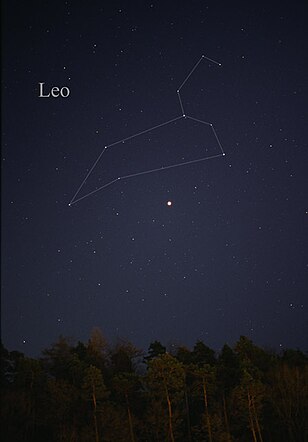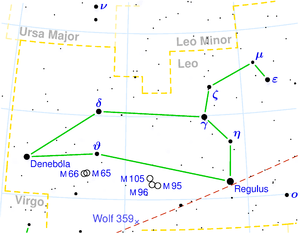Leo (constellation)
|
Leo constellation |
|
|---|---|
| Latin name | Leo |
| Latin genitive | Leonis |
| Abbreviation | Leo |
| Right ascension | 09 h 21 m 37 s to 11 h 58 m 26 s |
| declination | −6 ° 41 ′ 30 ″ to + 32 ° 58 ′ 09 ″ |
| surface | 946,964 deg² rank 12 |
| Completely visible | 83.7 ° N to 57.5 ° S |
| Observation time for Central Europe | Winter / spring |
| Number of stars brighter than 3 mag | 5 |
| Brightest star (size) | Regulus (1.36) |
| Meteor streams | |
|
Neighboring constellations ( clockwise from north ) |
|
| swell | IAU , |
 The constellation Leo |
|
The lion ( Latin : Leo , astronomical signs ♌, green line on the chart) is a constellation of the Zodiac . The red line on the map shows the ecliptic .
description
Leo is a prominent constellation that is easily recognizable in the spring sky. The bright stars Denebola , Regulus , Algieba (γ) and δ Leonis form the trunk. The stars ζ, μ and ε Leonis represent the head. This curved line of stars is sometimes referred to as a "sickle".
Leo contains some binary stars that are relatively easy to observe . Below the fuselage are the galaxies M 65 and M 66 . Together with the spiral galaxy NGC 3628, they form a small group of galaxies called the " Leo triplet " .
The ecliptic runs through the lion, so the sun , moon and planets move through the constellation. The lion thus belongs to the zodiac signs . The sun is located in the constellation Leo from August 11th to September 17th each year. Due to the precession movement of the earth's axis, the time of the passage of the sun has shifted compared to ancient times.
history
The identification of the star group with a lion could go back to the ancient Egyptians . At that time, the sun passed through the constellation Leo from mid-June to mid-July. During the greatest heat of summer, the lions left the desert and moved to the sandbanks of the Nile . However, the Egyptian constellation only included the "trunk". The star chain of the head (or the sickle) represented a knife for them. Other peoples of antiquity, such as the Persians , Syrians , Jews , Babylonians and Greeks also saw a lion in the constellation. Leo is one of the 48 classic constellations described by Ptolemy .
A group of faint stars, which originally represented the tassel on the lion's tail, became its own constellation in the 2nd century AD, the hair of Berenice (Coma Berenices).
mythology
In Greek mythology , the constellation represented the Nemean lion . This lion devastated villages and towns in the vicinity of the city of Nemea . His hard fur ricocheted off any weapon, making him invulnerable. The Greek hero Heracles (Hercules) eventually confronted the lion and strangled him with his bare hands. Heracles then wore the fur as a cloak that protected him from enemies.
In Jewish mythology, the lion is a symbol of the Messiah and is the only permitted representation in synagogues. The Messiah will be born from the tribe of Yehuda, which is shown in heraldry with the lion as a coat of arms.
Celestial objects
Stars
| B. | F. | Names or other designations | size | Lj | Spectral class |
|---|---|---|---|---|---|
| α | 32 | Regulus | 1.36 m | 78 | B7 V |
| γ | 41 | Algieba | 2.01 m | 126 | K1 III + G7 III |
| β | 94 | Denebola | 2.14 m | 36 | A3 V |
| δ | 68 | Zosma , Duhr, Gulbahar | 2.56 m | 58 | A4 V |
| ε | 17th | Ras Elased Australis , Algenubi | 2.97 m | 251 | G1 II |
| θ | 70 | Chertan , Coxa, Chort | 3.33 m | 170 | A2 V |
| ζ | 36 | Adhafera , Aldhafera | 3.43 m | 260 | F0 III |
| η | 30th | 3.48 m | 2000 | A0 Ib | |
| ο | 14th | Subra | 3.52 m | 116 | A5 V |
| ρ | 47 | 3.84 m | 2500 | B1 Ib | |
| μ | 24 | Rasalas , Alshemali | 3.88 m | 133 | K2 III |
| ι | 78 | 3.9 m | 70 | F2 + G3 | |
| σ | 77 | 4.05 m | |||
| υ | 91 | 4.30 m | |||
| 54 | 4.30 m | 200 | A1 + A2 | ||
| λ | 4th | Age f | 4.32 m | 250 | K5 III |
| R. | R Leonis | 4.4 to 11.3 m | 300 | M7 III | |
| φ | 74 | 4.45 m | |||
| κ | 1 | Minchir el-asad | 4.5 m | approx. 200 | K2 III |
| 93 | 4.50 m | ||||
| 72 | 4.56 m | ||||
| χ | 63 | 4.62 m | |||
| π | 29 | 4.68 m | |||
| 40 | 4.78 m | ||||
| τ | 84 | 4.95 m | |||
| ξ | 5 | 4.99 m | |||
| 10 | 5.00 m | ||||
| 48 | 5.07 m | ||||
| 75 | 5.18 m | ||||
| ν | 27 | 5.26 m | |||
| 92 | 5.26 m | ||||
| ψ | 16 | 5.36 m | |||
| 79 | 5.39 m | ||||
| ω | 2 | 5.40 m | 120 | F9 + G0 | |
| 37 | 5.42 m | ||||
| 46 | 5.43 m | ||||
| Wolf 359 , CN Leo | 13.53 m | 7.8 | M6 V |
β Leonis is a white shining star of spectral class A3, 36 light years away . It has 2.3 times the mass and 12 times the luminosity of our sun.
The name Denebola is of old Arabic origin and means "tail of the lion".
ε Leonis is 251 light years away. The names Ras Elased Australis or Algenubi are derived from "the southern head of the lion".
The names Rasalas or Ashemali for the 133 light-years distant star μ Leonis mean something like "northern head of the lion".
Wolf 359 is the fifth closest star in the vicinity of the Sun at a distance of only 7.8 light years. The deep red dwarf star has only 10 percent of the mass of our sun and shines very weakly. A larger telescope is needed to observe it .
Double stars
| system | Sizes | distance |
|---|---|---|
| α Leo | 1.36 / 7.6 / 13.0 m | 3 '/ 4 " |
| γ Leo | 2.2 / 3.5 m | 4.4 " |
| 78 Leo | 4.0 m / 6.7 m | 1.5 " |
| 54 Leo | 4.5 / 6.3 m | 6.6 " |
| ω Leo | 5.9 / 6.5 m | 0.5 " |
α Leonis is a strikingly bright star. The Latin name Regulus means "prince". It is a multiple star system , consisting of three components, 78 light years away. The luminous main star is a relatively young star, the age of which is estimated to be a few hundred million years. The star rotates around its own axis in just 15.9 hours and is severely flattened at the poles due to the strong centrifugal force . It is 3.5 times the diameter of our sun.
At a distance of 4,200 astronomical units , a pair of weaker stars orbits the main star in about 130,000 years. When viewed from Earth, the pair is 3 arc minutes from the main star. In prism binoculars , a 7.6 is m brighter companion star visible. The third component, which is only 13 m bright, is located at a distance of 4 arc seconds , and a larger telescope is required to observe it.
Regulus is located almost directly on the ecliptic, so he is regularly the moon covered .
γ Leonis is a binary star 90 light years away. The two components can already be observed with a small telescope with an opening of 4 cm.
The Arabic name Algieba means "forehead of the lion".
The system β Leonis is 42 light years away. The main star is around 20 times brighter than our sun. A companion star of the 6th magnitude is located at a distance of 19 arc minutes . Prism binoculars are sufficient for observation .
The Arabic name Denebola is derived from "lion's tail".
Variable stars
| star | size | period | Type |
|---|---|---|---|
| R Leo | 5.8 to 10.0 m | 311 days | Mira type |
R Leonis is a variable star of the Mira type , the brightness of which changes significantly over a period of 311 days. At the maximum it can still be seen with the naked eye. A telescope is required for observation during the minimum brightness.
Messier and NGC objects
| Messier (M) | NGC | other | size | Type | Name / description |
|---|---|---|---|---|---|
| 65 | 3623 | 9.5 m | Galaxy | ||
| 66 | 3627 | 9 m | Galaxy | ||
| 95 | 3351 | 10 m | Galaxy | Bar spiral | |
| 96 | 3368 | 9.5 m | Galaxy | ||
| 105 | 3379 | 9.5 m | Galaxy | ||
| 2903 | 9.0 m | Galaxy | |||
| 3384 | 10 m | Galaxy | |||
| 3521 | 9.2 m | Galaxy | |||
| 3628 | 10 m | Galaxy |
The pair of galaxies M 65 and M 66 , 40 million light years away, can already be seen in prism binoculars . In the telescope is NGC 3628 , a third galaxy visible.
Another group of galaxies are M 95 , M 96 , M 105 and NGC 3384 . The galaxies are also 40 million light years away.
See also
Web links
- Leo constellation A photographic journey through the signs of the zodiac
